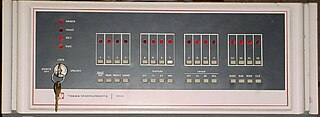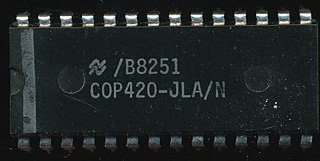Related Research Articles

The Data General Nova is a series of 16-bit minicomputers released by the American company Data General. The Nova family was very popular in the 1970s and ultimately sold tens of thousands of units.

The Intel 8080 ("eighty-eighty") is the second 8-bit microprocessor designed and manufactured by Intel. It first appeared in April 1974 and is an extended and enhanced variant of the earlier 8008 design, although without binary compatibility. The initial specified clock rate or frequency limit was 2 MHz, with common instructions using 4, 5, 7, 10, or 11 clock cycles. As a result, the processor is able to execute several hundred thousand instructions per second. Two faster variants, the 8080A-1 and 8080A-2, became available later with clock frequency limits of 3.125 MHz and 2.63 MHz respectively. The 8080 needs two support chips to function in most applications: the i8224 clock generator/driver and the i8228 bus controller. The 8080 is implemented in N-type metal–oxide–semiconductor logic (NMOS) using non-saturated enhancement mode transistors as loads thus demanding a +12 V and a −5 V voltage in addition to the main transistor–transistor logic (TTL) compatible +5 V.

The Zilog Z80 is an 8-bit microprocessor designed by Zilog that played an important role in the evolution of early computing. Software-compatible with the Intel 8080, it offered a compelling alternative due to its better integration and increased performance. The Z80 boasted fourteen registers compared to the 8080's seven, along with additional instructions for bit manipulation, making it a more powerful chip.

In computing, booting is the process of starting a computer as initiated via hardware such as a button on the computer or by a software command. After it is switched on, a computer's central processing unit (CPU) has no software in its main memory, so some process must load software into memory before it can be executed. This may be done by hardware or firmware in the CPU, or by a separate processor in the computer system.

The Intel 4004 is a 4-bit central processing unit (CPU) released by Intel Corporation in 1971. Sold for US$60, it was the first commercially produced microprocessor, and the first in a long line of Intel CPUs.

PIC is a family of microcontrollers made by Microchip Technology, derived from the PIC1640 originally developed by General Instrument's Microelectronics Division. The name PIC initially referred to Peripheral Interface Controller, and is currently expanded as Programmable Intelligent Computer. The first parts of the family were available in 1976; by 2013 the company had shipped more than twelve billion individual parts, used in a wide variety of embedded systems.
Serial Peripheral Interface (SPI) is a de facto standard for synchronous serial communication, used primarily in embedded systems for short-distance wired communication between integrated circuits.
4-bit computing is the use of computer architectures in which integers and other data units are 4 bits wide. 4-bit central processing unit (CPU) and arithmetic logic unit (ALU) architectures are those that are based on registers or data buses of that size. A group of four bits is also called a nibble and has 24 = 16 possible values, with a range of 0 to 15.
Mach-O, short for Mach object file format, is a file format for executables, object code, shared libraries, dynamically loaded code, and core dumps. It was developed to replace the a.out format.

The Texas Instruments LPC Speech Chips are a series of speech synthesizer digital signal processor integrated circuits created by Texas Instruments beginning in 1978. They continued to be developed and marketed for many years, though the speech department moved around several times within TI until finally dissolving in late 2001. The rights to the speech-specific subset of the MSP line, the last remaining line of TI speech products as of 2001, were sold to Sensory, Inc. in October 2001.
The TMS9900 was one of the first commercially available, single-chip 16-bit microprocessors. Introduced in June 1976, it implemented Texas Instruments' TI-990 minicomputer architecture in a single-chip format, and was initially used for low-end models of that lineup.

The Fairchild F8 is an 8-bit microprocessor system from Fairchild Semiconductor, announced in 1974 and shipped in 1975. The original processor family included four main 40-pin integrated circuits (ICs); the 3850 CPU which was the arithmetic logic unit, the 3851 Program Storage Unit (PSU) which contained 1 KB of program ROM and handled instruction decoding, and the optional 3852 Dynamic Memory Interface (DMI) or 3853 Static Memory Interface (SMI) to control additional RAM or ROM holding the user programs or data. The 3854 DMA was another optional system that added direct memory access into the RAM controlled by the 3852.
The Atmel AVR instruction set is the machine language for the Atmel AVR, a modified Harvard architecture 8-bit RISC single chip microcontroller which was developed by Atmel in 1996. The AVR was one of the first microcontroller families to use on-chip flash memory for program storage.
XDR DRAM is a high-performance dynamic random-access memory interface. It is based on and succeeds RDRAM. Competing technologies include DDR2 and GDDR4.
Relocation is the process of assigning load addresses for position-dependent code and data of a program and adjusting the code and data to reflect the assigned addresses. Prior to the advent of multiprocess systems, and still in many embedded systems, the addresses for objects are absolute starting at a known location, often zero. Since multiprocessing systems dynamically link and switch between programs it became necessary to be able to relocate objects using position-independent code. A linker usually performs relocation in conjunction with symbol resolution, the process of searching files and libraries to replace symbolic references or names of libraries with actual usable addresses in memory before running a program.

The TI-990 was a series of 16-bit minicomputers sold by Texas Instruments (TI) in the 1970s and 1980s. The TI-990 was a replacement for TI's earlier minicomputer systems, the TI-960 and the TI-980. It had several unique features, and was easier to program than its predecessors.

The CP1600 is a 16-bit microprocessor created in a partnership between General Instrument and Honeywell, introduced in February 1975. It is one of the first single-chip 16-bit processors. The overall design bears a strong resemblance to the PDP-11.

The TMS1000 is a family of microcontrollers introduced by Texas Instruments in 1974.
The Ferranti F100-L was a 16-bit microprocessor family announced by Ferranti in 1976 which entered production in 1977. It was the first microprocessor designed in Europe, and among the first 16-bit single-chip CPUs. It was designed with military use in mind, able to work in a very wide temperature range and radiation hardened. To deliver these capabilities, the F100 was implemented using bipolar junction transistors, as opposed to the metal oxide semiconductor (MOS) process used by most other processors of the era. The family included a variety of support chips including a multiply/divide unit, various memory support chips, timers and serial bus controllers.

The COP400 or COP II is a 4-bit microcontroller family introduced in 1977 by National Semiconductor as a follow-on product to their original PMOS COP microcontroller. COP400 family members are complete microcomputers containing internal timing, logic, ROM, RAM, and I/O necessary to implement dedicated controllers. Some COP400 devices were second-sourced by Western Digital as the WD4200 family. In the Soviet Union several COP400 microcontrollers were manufactured as the 1820 series.
References
- 1 2 3 "TMS 6100 - Voice Synthesys Memory Data Manual" (PDF). www.ti99.com. Retrieved 2024-08-06.